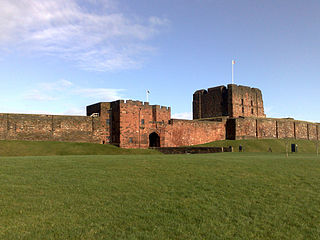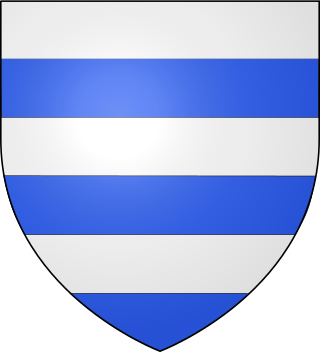Related Research Articles

Robert I, popularly known as Robert the Bruce, was King of Scots from 1306 to his death in 1329. Robert led Scotland during the First War of Scottish Independence against England. He fought successfully during his reign to restore Scotland to an independent kingdom and is regarded in Scotland as a national hero.

The Wars of Scottish Independence were a series of military campaigns fought between the Kingdom of Scotland and the Kingdom of England in the late 13th and early 14th centuries.

John Balliol or John de Balliol, known derisively as Toom Tabard, was King of Scots from 1292 to 1296. Little is known of his early life. After the death of Margaret, Maid of Norway, Scotland entered an interregnum during which several competitors for the Crown of Scotland put forward claims. Balliol was chosen from among them as the new King of Scotland by a group of selected noblemen headed by King Edward I of England.

The Battle of Bannockburn was fought on 23–24 June 1314, between the army of Robert the Bruce, King of Scots, and the army of King Edward II of England, during the First War of Scottish Independence. It was a decisive victory for Robert Bruce and formed a major turning point in the war, which ended 14 years later with the de jure restoration of Scottish independence under the Treaty of Edinburgh–Northampton. For this reason, the Battle of Bannockburn is widely considered a landmark moment in Scottish history.

William de Valence, born Guillaume de Lusignan, was a French nobleman and knight who became important in English politics due to his relationship to King Henry III of England. He was heavily involved in the Second Barons' War, supporting the king and Prince Edward against the rebels led by Simon de Montfort. He took the name de Valence after his birthplace, the Cistercian abbey of Valence, near Lusignan in Poitou.

Sir James Douglas was a Scottish knight and feudal lord. He was one of the chief commanders during the Wars of Scottish Independence.

William III de Cantilupe was the 3rd feudal baron of Eaton Bray in Bedfordshire, and jure uxoris was feudal baron of Totnes in Devon and Lord of Abergavenny. His chief residences were at Calne in Wiltshire and Aston Cantlow, in Warwickshire, until he inherited Abergavenny Castle and the other estates of that lordship.
Walter Stewart was the 6th Hereditary High Steward of Scotland and was the father of King Robert II of Scotland, the first Stewart monarch.

Isabella MacDuff, Countess of Buchan, was a significant figure in the Wars of Scottish Independence.

Robert de Clifford, 1st Baron de Clifford, of Appleby Castle, Westmorland, feudal baron of Appleby and feudal baron of Skipton in Yorkshire, was an English soldier who became 1st Lord Warden of the Marches, responsible for defending the English border with Scotland.

Henry de Hastings of Ashill, Norfolk, was a supporter of Simon de Montfort in his rebellion against King Henry III. He led the Londoners at the Battle of Lewes in 1264, where he was taken prisoner, and fought at the Battle of Evesham in 1265, where de Montfort was killed. He resisted King Henry III's extensive siege of Kenilworth and after the Dictum of Kenilworth he commanded the last remnants of the baronial party when they made their last stand in the Isle of Ely, but submitted to the king in July 1267. In 1264 he was created a supposed baron by de Montfort, which title had no legal validity following the suppression of the revolt.
Events from the 1310s in England.

Sir Robert Keith was a Scottish knight, diplomat, and hereditary Marischal of Scotland who commanded forces loyal to Robert Bruce at the Battle of Bannockburn.
Alice Comyn, Countess of Buchan, Lady Beaumont was a Scottish noblewoman, a member of the powerful Comyn family which supported the Balliols, claimants to the disputed Scottish throne against their rivals, the Bruces. She was the niece of John Comyn, Earl of Buchan, to whom she was also heiress, and after his death the Earldom of Buchan was successfully claimed by her husband Henry de Beaumont, Earl of Buchan, by right of his wife. His long struggle to claim her Earldom of Buchan was one of the causes of the Second War of Scottish Independence.

John Segrave, 2nd Baron Segrave was an English commander in the First War of Scottish Independence.

John Comyn IV, Lord of Badenoch was the son of John III "The Red" Comyn, former leader of Scottish rebels against the English, who was killed by Robert the Bruce in the Greyfriars church in Dumfries on 10 February 1306. He was sent to England after his father's death by his mother Jeanne de Valence.

Richard Grey, 2nd Baron Grey of Codnor, of Codnor Castle, was an English soldier and diplomat.

Thomas de Ufford, Lord of Wrentham, was an English noble. He was killed during the Battle of Bannockburn against the Scots on 23 or 24 June 1314.

John Lovel, 2nd Baron Lovel, Lord of Titchmarsh, was an English noble. He was killed during the Battle of Bannockburn against the Scots on 23 or 24 June 1314.
References
- ↑ Stringer, Keith J. (2004). "Hastings, Edmund, Lord Hastings of Inchmahome (1263x9–1314), soldier and administrator" . Oxford Dictionary of National Biography (online ed.). Oxford University Press. doi:10.1093/ref:odnb/12561. ISBN 978-0-19-861412-8 . Retrieved 29 December 2021.(Subscription or UK public library membership required.)
- Cokayne, George Edward and H.A. Doubleday et al. eds. Complete Peerage of England, Scotland, Ireland, Great Britain and the United Kingdom. Volume VI, 2nd edition. London, 1926.